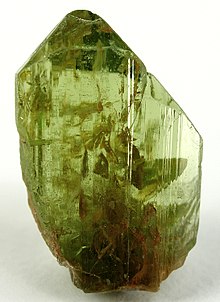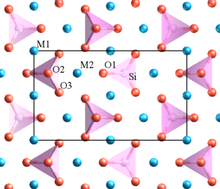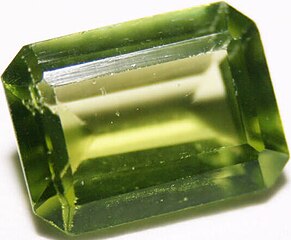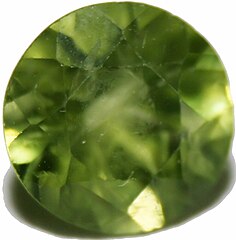Peridot
| Peridot | |
|---|---|
 | |
| General | |
| Category | Silicate minerals |
| Formula (repeating unit) | (Mg, Fe)2SiO4 |
| Crystal system | Orthorhombic |
| Identification | |
| Color | Yellow, toyellow-green,olive-green,to brownish, sometimes alime green,to emerald-ish hue |
| Twinning | Uncommon, simple twinning can occur on {100}, {011},{012}, cyclic twinning on {031} |
| Cleavage | Poor on {010} and {110}, {010} cleavage improves with increasing iron content |
| Fracture | Conchoidal |
| Mohs scalehardness | 6.5–7 |
| Luster | Vitreous to oily |
| Streak | Colorless |
| Diaphaneity | Translucent to transparent |
| Specific gravity | 3.2–4.3 |
| Refractive index | 1.64–1.70 |
| Birefringence | +0.036 |
| Pleochroism | Weak pale yellow-green to yellow, yellow to yellow orange |
| Melting point | between 1,200 and 1,900 degrees celsius |
| Fusibility | Infusible avoid thermal shock |
| Solubility | Slow in HCl to form gelatinous silica |
Peridot(/ˈpɛrɪˌdɒt,-ˌdoʊ/PERR-ih-dot, -doh), sometimes calledchrysolite,is ayellowish-greentransparent variety ofolivine.Peridot is one of the fewgemstonesthat occur in only one color.
Peridot can be found inmaficandultramafic rocksoccurring inlavaandperidotitexenolithsof themantle.The gem occurs in silica-deficient rocks such as volcanicbasaltandpallasiticmeteorites.Peridot is one of only two gems observed to be formed not inEarth's crust,but in the molten rock of the upper mantle.[1]Gem-quality peridot is rare on Earth's surface due to its susceptibility to weathering during its movement from deep within the mantle to the surface.[2]Peridot has achemical formulaof(Mg, Fe)2SiO4.Peridot is one of thebirthstonesfor the month of August.[3]
Etymology[edit]
The origin of the nameperidotis uncertain. TheOxford English Dictionarysuggests an alteration ofAnglo–Normanpedoretés(classicalLatinpæderot-), a kind ofopal,rather than theArabicwordfaridat,meaning "gem".
TheMiddle English Dictionary's entry onperidotincludes several variations:peridod,peritot,pelidodandpilidod — other variants substituteyfor theis seen here.[4]
The earliest use in England is in the register of theSt Albans Abbey,in Latin, and its translation in 1705 is possibly the first use ofperidotin English. It records that on his death in 1245, Bishop John bequeathed various items, including peridot, to the Abbey.[5]
Appearance[edit]
Peridot is one of the few gemstones that occur in only one color: anolive-green.The intensity and tint of the green, however, depends on the percentage ofironin the crystal structure, so the color of individual peridot gems can vary from yellow, to olive, to brownish-green. In rare cases, peridot may have a medium-dark toned, pure green with no secondary yellow hue or brown mask. Lighter-colored gems are due to lowerironconcentrations.[6]
Mineral properties[edit]
Crystal structure[edit]

The molecular structure of peridot consists of isomorphic olivine, silicate, magnesium and iron in anorthorhombic crystal system.In an alternative view, the atomic structure can be described as a hexagonal, close-packed array of oxygenionswith half of the octahedral sites occupied by magnesium or iron ions and one-eighth of the tetrahedral sites occupied by silicon ions.
Surface property[edit]
Oxidation of peridot does not occur at natural surface temperature and pressure but begins to occur slowly at 600 °C (870 K) with rates increasing with temperature.[7]The oxidation of the olivine occurs by an initial breakdown of thefayalitecomponent, and subsequent reaction with the forsterite component, to givemagnetiteandorthopyroxene.
Occurrence[edit]
Geologically[edit]
Olivine,of which peridot is a type, is a common mineral inmaficandultramafic rocks,often found inlavaand inperidotitexenolithsof themantle,which lava carries to the surface; however, gem-quality peridot occurs in only a fraction of these settings. Peridots can also be found in meteorites.
Peridots can be differentiated by size and composition. A peridot formed as a result of volcanic activity tends to contain higher concentrations of lithium, nickel and zinc than those found in meteorites.[8]
Olivine is an abundant mineral, but gem-quality peridot is rather rare due to itschemical instabilityon Earth's surface. Olivine is usually found as small grains and tends to exist in a heavily weathered state, unsuitable for decorative use. Large crystals offorsterite,the variety most often used to cut peridot gems, are rare; as a result, peridot is considered to beprecious.
In the ancient world, the mining of peridot was calledtopaziosthen, onSt. John's Island in the Red Seabegan about 300 B.C.[9]
The principal source of peridot olivine today is theSan Carlos Apache Indian Reservationin Arizona.[10]It is also mined at another location inArizona,and inArkansas,Hawaii,Nevada,andNew MexicoatKilbourne Hole,in the US; and inAustralia,Brazil,China,Egypt,Kenya,Mexico,Myanmar(Burma),Norway,Pakistan,Saudi Arabia,South Africa,Sri Lanka,andTanzania.[citation needed]
In meteorites[edit]

Peridot crystals have been collected from somepallasitemeteorites.The most commonly studied pallasitic peridot belongs to the Indonesian Jeppara meteorite, but others exist such as the Brenham, Esquel, Fukang, and Imilac meteorites.[11] Pallasitic (extraterrestrial) peridot differs chemically from its earthbound counterpart, in that pallasitic peridot lacks nickel.[12]
Gemology[edit]

All minerals that areorthorhombic,like peridot, arebiaxialand are defined by three principal axes: α, β, γ. Refractive index readings of faceted gems contain indices α = 1.653, β = 1.670, and γ = 1.689 with a corresponding biaxial birefringence of 0.036. The refractive index, as well as the specific gravity, vary slightly depending on the iron concentration; a dominant cause of peridot color variation. The numerical β index tends to shift towards the α and γ index with a corresponding increase in the iron concentration—forming the iron-rich end memberfayalite.[13]
A study of Chinese peridot gem samples determined the specific gravity hydro-statically to be 3.36. The visible-light spectroscopy of the same Chinese peridot samples showed light bands between 493.0 and 481.0 nm, the strongest absorption at 492.0 nm.[14]
Inclusions are common in peridot crystals but their presence depends on the location it is found and the geological conditions that led to the crystallization of the peridot. Primary negative crystals—rounded gas bubbles—form in situ with peridot and are common in Hawaiian peridots. Secondary negative crystals form in peridot fractures. Lily pad cleavages, seen often in San Carlos peridots, are a type of secondary negative crystal and are viewed easily under reflected light as circular discs surrounding a negative crystal. Silky and rod-like inclusions are common in Pakistani peridots.[15]The most common mineral inclusion in peridot is the chromium-rich mineralchromite.Magnesium-rich minerals also can exist in the form ofpyropeandmagnesiochromite.These two types of mineral inclusions typically surrounded lily-pad cleavages. Biotite flakes appear flat, brown, translucent, and tabular.[16]
The largest cut peridot olivine is a 310-carat(62-gram) specimen in theSmithsonian Museumin Washington, D.C.
Cultural history[edit]
Peridot has been prized since the earliest civilizations for its claimed protective powers to drive away fears and nightmares, according to superstitions. It is believed by some superstitious people to carry the gift of "inner radiance", sharpening the mind and opening it to new levels of awareness and growth, helping one to recognize and realize one's destiny and spiritual purpose. There is no scientific evidence for such claims.
Peridot is sometimes mistaken foremeraldsand other green gems.[17]NotablegemologistGeorge Frederick Kunzdiscussed the confusion betweenemeraldsand peridot in manychurch treasures,notably the "Three Magi"treasure in theDomofCologne,Germany.[18][1]
Peridot olivine is thebirthstonefor the month of August.[19]
Gallery[edit]
-
Peridot from the San Carlos Apache Reservation in Arizona.
-
Olive green peridot
-
Peridot with milky inclusions
References[edit]
- ^ab"Peridot Crystals: Formation & Locations".Rock & Gem Magazine.2023-07-10.Retrieved2024-01-21.
- ^"PERIDOT main page".Geology - The University of Texas at Austin.Retrieved2024-01-21.
- ^"August Birthstone: Peridot | Color, Meanings, and Symbolism".Old Farmer's Almanac.
- ^Sherman M Kuhn (1982).Middle English Dictionary.University of Michigan Press. pp. 818–.ISBN0-472-01163-4.
- ^Sir James Ware (1705).The Antiquities and History of Ireland.A. Crook. pp. 628–.
- ^Wise, Richard W. (2016).Secrets Of The Gem Trade, The Connoisseur's Guide To Precious Gemstones(2nd ed.). Lenox, Massachusetts: Brunswick House Press. p. 220.ISBN9780972822329.
- ^Knafelc, Joseph; Filiberto, Justin; Ferré, Eric C.; Conder, James A.; Costello, Lacey; Crandall, Jake R.; Dyar, M. Darby; Friedman, Sarah A.; Hummer, Daniel R.; Schwenzer, Susanne P. (2019-05-01)."The effect of oxidation on the mineralogy and magnetic properties of olivine".American Mineralogist.104(5): 694–702.Bibcode:2019AmMin.104..694K.doi:10.2138/am-2019-6829.ISSN0003-004X.S2CID155508562.
- ^Shen, A., et al. (2011). Identification of Extraterrestrial Peridot by trace elements,Gems & Gemology,p. 208-213
- ^St. John's Island peridot information and historyatMindat.org
- ^"Although some good olive-colored crystals are found in a few other places, like Burma, China, Zambia, and Pakistan, ninety percent of all known peridots are found in just one place. It is a Native American reservation, and it is located in a little-visited corner of the United States. San Carlos" Finlay, Victoria. Jewels: A Secret History (Kindle Locations 2543–2546). Random House Publishing Group. Kindle Edition.
- ^Leelawatanasuk, Thanong; Atichat, Wilawan; Thye Sun, Tay; Sriprasert, Boontawee; Jakkawanvibul, Jirapit (2014). "Some Characteristics of Taaffeite from Myanmar".The Journal of Gemmology.34(2): 144–148.doi:10.15506/jog.2014.34.2.144.ISSN1355-4565.
- ^[Alien Sightings: Pallasitehttps://stonegrouplabs /wp-content/uploads/2021/06/0314GG-MarAprGMNPallasite.pdfPallasite.pdf]
- ^Koivula, John I. (1981)."San Carlos Peridot"(PDF).Gems & Gemology.17(4): 205–214.doi:10.5741/gems.17.4.205.Retrieved14 February2023.
- ^Koivula, John I.; Fryer, C. W. (1986-04-01)."The Gemological Characteristics of Chinese Peridot".Gems & Gemology.22(1): 38–40.doi:10.5741/GEMS.22.1.38.ISSN0016-626X.
- ^"Sapat Gali, Naran, Kaghan Valley, Mansehra District, Khyber Pakhtunkhwa Province, Pakistan".
- ^"Biotite as inclusions".Dictionary of Gems and Gemology.Springer. 2009. p. 87.doi:10.1007/978-3-540-72816-0_2288.ISBN978-3-540-72795-8.
- ^"Peridot Gem Guide and Properties Chart | Gemstones".gemstones.Retrieved2022-09-14.
- ^Kunz, George Frederick (June 1, 1971).The Curious Lore of Precious Stones.New York, NY: Dover Publications. p. 66.ISBN0-486-22227-6.
- ^"Birthstones For Each Month".Gemological Institute of America.Retrieved5 February2021.




